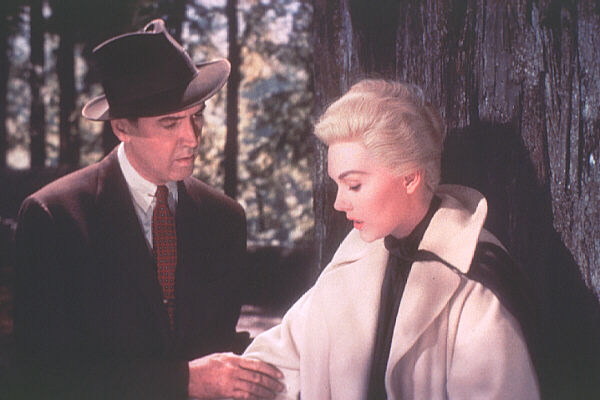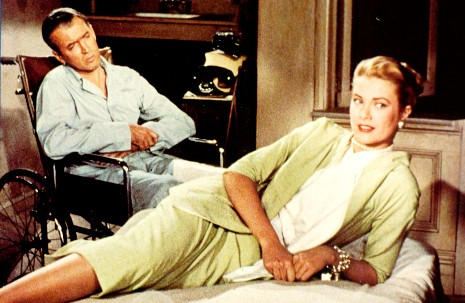Alfred Hitchcock is often considered as one of the most prominent filmmakers who created unique images of women and transformed traditional interpretations and understanding of gender roles. As many critics have observed, males are usually the central force of the narrative, with their status an extension of this domination. Despite, or perhaps because of, this standard male supremacy, the evidence shows that women are much freer than men to explore emotions and character types, from wilting flowers to stoic martinet. Role reversals and fashionable dressing in films follow peaks that correspond to periods of greater experimentation in society at large.
Hitchcock offered significant new models in the treatment of female impersonation, shocking audiences and critics and breaking the bonds of “good taste” until those boundaries ceased to be standardized. Vertigo is one of the most popular films portraying the sense of dislocation and confusion that it projects. Leaving the viewer off balance is precisely what the movie wants to do (Hirsch, 2001). It also makes you feel the obsessions of the 1950s and makes them seem enough to murder for. Hitchcock’s fascination with the icy blonde love object is full of psychological double entendres. In this movie, a fashionable woman, Barbara, is a mysterious woman.
Hitchcock viewed that love objects both ironically and adoringly as viewers admired Kim Novak in what was surely her best role. In addition to everything else, Vertigo is one of the most successful of the 1950s films that dealt with analysis (Hirsch, 2001). Though some of the terms sound hokey, like “acute guilt complex” and “acute melancholia,” what viewers see has the ring of psychological truth. Stewart plays an emphatically rational detective who decides to retire honourably after an attack of acrophobia (Auiler & Scorsese 2000). The initial symptom of this fear of heights is the vertigo of the film’s title.
Not so curiously, it is the very same dizziness and paranoia he feels when his romantic life goes wrong. In this case, romantic love is heated by fashion and luxury symbolized by Barbara. Hitchcock examined the male psyche through Barbara Bel Geddes as the leading man’s friend.

In this film, Hitchcock portrayed that it is the distancing of the love object (Novak) by her money, with the additional attraction of being a rich man’s wife, that adds the glamour necessary for male emotion, or this particular male’s emotion.
And clothes not only make the woman, but they also make the male libido go zowie. Vertigo, which is violent without being bloody, is equally about affluence: what it takes to be a white-gloved lady; the filmmaker and the audience observe with envy the manners and morals of a particular class. To Hitchcock’s and the actors’ credit, opulence looks good to us even as we see how it messes people up. The setting of the film is one of San Francisco’s refined neighbourhoods, which also provides the hilly, winding streets: a perfect visual metaphor for the hero’s emotional and mental state (Auiler & Scorsese 2000).
The film Rear Window (1954) portrays a fashion model Lisa Carol Fremont and her perception of the world and love relations. The main themes of this film are marital relations and voyeurism, murder, and suspense. Similar to other movies, Rear Window is simply seeing, and accepting, a woman for what she is, and what she has earned, in the man’s world of tough gains made, with certain rules played for all they are worth (Kaplan, 1990).
Theorizing about all the multitudinous changes women’s self-concepts and filmmaker’s views of them have offered in the 1950s is all well and good. But nothing and no one speaks so loudly or clearly as the women themselves, discussing the parts they’ve picked and sometimes created in movies. Just as the attempt to conform to a socially recognized uniform represents a desire for cohesion, social order, and unity, the opposite behaviour of deliberately defying dress codes marks a demand for departure from the old order, the anarchic assertion of individual freedom. Both impulses have their appeal for various segments of the population at different periods of individual and social development.
In looking at individual films that offer role reversal, cross-dressing, and exchanges in costumes, we can examine our attitudes about male and female images as well as the appeal of androgyny for our past and present society (Kaplan, 1990). The female has long been the mythic symbol of wisdom and self-sufficiency, a figure whose in-between status inspires fascination, dread, and reverence. In our own culture, priests and nuns have historically striven for angelic wisdom by denying their sexuality and forfeiting participation in the gender-related rituals of mating and procreating. This ad unites Americanism, feminine fashion, and rayon in a single blow (Kaplan, 1990; Golden, 2004).

Psycho (1960) is one of the most popular films portraying female impersonation and voyeurism. Critics admit that male impersonation, on the other hand, almost dropped from the screen, its relative absence being, in part, a consequence of the fact that women now wear pants in everyday life. Indeed, many films that depict women in what had been traditionally male roles are no longer actual reversals; they are simply reflections of changing economic and social realities (Silver & Ursini 2004).
The shift in the status of women is mirrored in the change in depictions of female impersonation, the distortions in these images disclosing the anxiety with which changes have been greeted by many men. Hitchcock then undermined the supposed harmlessness of the little old lady impersonator with Psycho in 1960. Impersonating a woman involves anxiety over the loss of power because it means that the male must identify with a typically lower-status figure. The function of female impersonation in films changed as the images of real women in society changed. What had served as a refuge from the male world, the protective mother figure, began to turn into a domineering discipline figure soon after World War 11 (Silver & Ursini 2004).

By the beginning of the sixties, the point of view expressed in most cross-dressing films was much closer to the anxiety-ridden hostility than to the fun-loving stage impersonations of vaudeville, the British music hall, and the public school and dramatic traditions. To understand recent incidences of female impersonation in film, it may be most profitable to regard them in terms of their appeal to audiences. His variety signalled a breakdown of stereotypes in female fashion, a trend that was to continue into an era in which true drag queens would make their popular screen debut. The shift toward imitation of stronger female types points to a drastic alteration of popular views on what constitutes masculinity and femininity (Silver & Ursini 2004).
Alfred Hitchcock’s Psycho (1960) was the first major work in American film history to explore the psychotic manifestation of female impersonation. The character of Norman Bates was to become synonymous with a newly discovered phenomenon, the pathological “Momma’s boy.” Norman Bates so despises and yet so identifies with his domineering mother that after her death he preserves her body by stuffing her, and he “becomes” his mother by dressing in her clothes, killing anyone who threatens that closed, restricted relationship.
The film was based on the novel inspired by a real incident in which “a man kept his mother’s body in his house, somewhere in Wisconsin,” but under Hitchcock’s direction, the macabre tale becomes a profound and complex work of art (Silver & Ursini 2004). The film teaches us not only to mistrust exterior reality but to mistrust the filmmaker as well. Although Hitchcock was not particularly concerned with the subject of cross-dressing per se, some of the touches that make the film so cinematically innovative were necessitated by the inherent deceptiveness of impersonation Hitchcock creates a brilliant synthesis of form and content here (Hirsch 2001).
By calling attention to the filmmaking process itself, he distracts the audience from an inconsistency in the actual content of the film (the fact that Norman’s mother is a stuffed, dead woman). This kind of interplay between form and content is typical of much of Hitchcock’s work, but it seems that this subject called on the director to exceed himself in manipulation and deception because of the very nature of the cross-dressing situation (Morris, 1997; Golden, 2004).
What makes his solution to the problem of concealing true identity so elegant is the fact that this angle also creates tremendous suspense, a sense that some evil presence is looking on from above. The length of the shot from above builds so much tension that a cut to any other camera angle comes as a shock.
No director after Hitchcock was to master the theme with such purely film devices. Rather, other directors turned to the expertise of the female impersonator to fool audiences when the plot demanded such deception (Morris, 1997). According to Silver & Ursini (2004): “ increasing film noir style seen in Hollywood’s female gothic cycle accelerated over the course of the duration as seen in Hitchcock’s noir espionage thriller Notorious (1946). How gender (and masculinity) played out on Hollywood screens was significant” (p. 165).
In general, Hitchcock’s fashionable women are no longer the sweet, harmless matrons. In the past two decades, male characters have generally impersonated female figures of power. The decrease in male impersonation and the increase in female impersonation coincide with an apparent rise in prestige for women within society. The nature of female impersonation has changed drastically, becoming much more explicit sexually and possibly more threatening (Moerbeek, 2006).
When censorship bans were lifted, previously covert connections between female impersonation and homosexuality suddenly became overt, populating the screen with all the varieties of impersonators that exist in real life. These films also explore the individual’s confrontation with “the Other.” Imitation of the otherness of the female arouses curiosity, desire, fear, and even loathing in male characters within such films. When a film concentrates on the comic aspects, as did the majority of films before 1960, the ultimate movement is toward reconciling dichotomies between playful curiosity and obsessive fear. A film that presents a likeable yet powerless woman is no less sexist than a film that presents a despicable yet powerful woman; in fact, the latter film may carry a heavy misogynist message while implying the superiority of females over males (Moerbeek, 2006).
The cross-dressing films of the sixties follow this pattern of misogyny and fear of the powerful female, but in the mid-seventies, an interesting change occurs. For the first time, female impersonators become sympathetic characters–occasionally comic, yet no longer the figures of derision or harmless ridicule (Moerbeek, 2006).
Following Silver and Ursini (2004) Psycho is a culmination of Hitchcock’s work, combining his recurrent themes of voyeurism, the doppelganger, and extreme sexual repression. “Hitchcock obviously favours women who are reserved and who will not resist his control.
He relegated his performers to essential but nonetheless subsidiary roles” (Hirsch 2001, p. 142). Hitchcock had dealt with the transvestite character early in his British career in Murder (1930), in which a woman is suspected of being a murderer until it is discovered that her fiancé (who leads a double life as a transvestite trapeze artist) is the real culprit. Much later in Hitchcock’s career, in To Catch a Thief (1955), he directs Cary Grant as a reformed cat burglar who finally catches the woman who has been impersonating him, robbing houses in imitation of his style (Moerbeek, 2006).
Using the theme and techniques of voyeurism, Hitchcock tests sexual boundaries, exploring fearful as well as pleasurable fantasies in ways that leave the viewer wondering whether Hitchcock worships or loathes women. Sexual power is a central theme of his films, and in Hitchcock’s world characters’ manipulation of each other usually involves the female taking on male characteristics. As is true of many films that employ cross-dressing, Hitchcock’s masculinization of the female is often accompanied by the feminization of the male, with the role exchanges reinforced by visual cues (Moerbeek, 2006). In the process of the film, his women characters mature and become the ideal woman, an impression that is strengthened her with the other characters in the films.
Hitchcock’s careful manipulation of form and content is informed by his astute understanding of the expectations, demands, and responses of his audience. This sensitivity points to two of the essential differences between pre-Psycho and post-psycho treatments of serious female fashion. In earlier films, the audience had been aware of the deception, but in the sixties and seventies, filmmakers increasingly chose to leave viewers in the dark, often until the end of the film.
In part, this is a difference in the prevalent genre featuring female impersonation before 1960–comedy–and the more serious films, often with shock value, after 1960. In older comedies (and in the vaudeville throwbacks still occasionally produced in the sixties and seventies), usually, the audience must be aware of the deception to appreciate the jokes (Kaplan, 1990).
An image of fashionable women attracts the audience by leading their vision, with the camera directing attention to forbidden images that often create involuntary responses of shock and fear. Perhaps more pervasive and disturbing than the intrusion of sudden violence is the sense of inevitability in the film’s conclusion. Psycho ends with a scene of very literal entrapment. The camera peers through a tiny window for the final shot of Norman Bates locked forever in one small room; his personality (whatever he had) is trapped now in the persona of his domineering, controlling mother, who cannot even allow the flies in the room their freedom of flight. In Psycho the only alternative to complete repression of sexuality is violence, and the film’s conclusion neatly locks this threat into a padded cell (Kaplan, 1990).
In sum, Hitchcock creates unique and outstanding images of fashionable women which contrast with images of the 1920-1930s. His fashionable women are love objects for male characters. Almost all of Hitchcock’s work abounds in images of the sexual repression he had observed at a personal level and saw mirrored in the American scene. This would seem to be a strong statement for women and minority rights, but Hitchcock’s films glosses over these issues in the end. Using images of fashionable women, Hitchcock reinforces stereotypical notions of masculinity and femininity; it is a subspecies even more thoroughly dominated by males than is the West.
Bibliography
- Auiler, D., Scorsese, M. Vertigo: The Making of a Hitchcock Classic. St. Martin’s Griffin; First Edition edition, 2000.
- Golden, C. 2004, From Punishment to Possibility: Re-imagining Hitchcockian Paradigms in the New York Trilogy. Mosaic (Winnipeg), vol. 37, pp. 93-94.
- Hirsch, R. 2001, The Dark Side of the Screen: Film Noir. Da Capo Press.
- Kaplan, E. A. 1990, Women in Film Noir. British Film Institute; New edition.
- Moerbeek, K. 2006, Alfred Hitchcock: The Master of Suspense: A Pop-up Book. Little Simon.
- Morris, Ch. D. 1997, The Allegory of Seeing in Hitchcock’s Silent Films. Film Criticism, vol. 22, pp. 27-37.
- Silver, A., Ursini, J. 2004, Film Noir Reader 4: The Crucial Films and Themes. Limelight Editions; 1 edition.